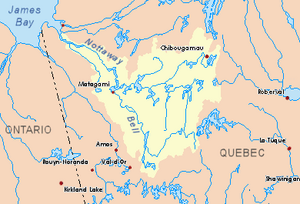Panache River facts for kids
Quick facts for kids Panache |
|
|---|---|

Watershed of Nottaway River
|
|
| Other name(s) | French: Rivière au Panache |
| Country | Canada |
| Province | Quebec |
| Region | Abitibi-Témiscamingue |
| Physical characteristics | |
| Main source | Forested creek Senneterre, Abitibi-Témiscamingue, Quebec 407 m (1,335 ft) 49°08′51″N 76°06′37″W / 49.14750°N 76.11028°W |
| River mouth | Wetetnagami River Senneterre, Abitibi-Témiscamingue, Quebec 349 m (1,145 ft) 49°08′51″N 76°06′37″W / 49.14750°N 76.11028°W |
| Length | 61.6 km (38.3 mi) |
| Basin features | |
| Tributaries |
|
The Panache River is a river in Quebec, Canada. It flows into the Wetetnagami River near the town of Senneterre. This area is part of the Abitibi-Témiscamingue region.
As it flows, the Panache River passes through several areas called townships. These include Urban, Carpiquet, Muy, and Effiat.
The main activities in the area around the river are forestry (cutting down trees for wood) and recreational tourism (people visiting for fun activities like fishing or camping).
Forest roads, like R1051 and R1053, help people get around the Panache River valley. These roads also lead to the Wetetnagami Lake Biodiversity Reserve, a special protected area.
The river's surface usually freezes over from early November until mid-May. However, it's generally safe to walk or travel on the ice from mid-November to mid-April.
Contents
Where the Panache River Flows
The Panache River is part of a larger network of rivers. It starts from a small forest stream in Senneterre, Quebec. This starting point is about 31.7 kilometers (19.7 miles) east of where the Panache River joins the Wetetnagami River.
Rivers Nearby
Many other rivers and lakes are close to the Panache River. These include:
- To the north: Muy River, Fortier River (Panache River), Pierrefonds River, Nicobi Lake, Nicobi River, and Opawica River.
- To the east: St-Cyr River, Hebert River, Lake Hebert, and Doda Lake.
- To the south: Dazemard River, Macho River, Corriveau Creek, Wetetnagami River, and Saint-Père River.
- To the west: O'Sullivan River, Wetetnagami River, and Wilson Lake.
The River's Journey
The Panache River travels about 61.6 kilometers (38.3 miles) from its source to its mouth. Here's how its journey generally goes:
- It starts by flowing southwest through Urban Township.
- Then, it turns west, making a curve to the south, until it meets Corriveau Brook.
- Next, it heads north, then northeast, to join the Fortier River.
- It continues northwest, making a big curve, until it meets the Pierrefonds River.
- After that, it flows southwest towards the Effiat Township.
- Finally, in Effiat Township, it flows northwest, then curves southwest, and eventually east along the border of Muy and Effiat townships until it reaches its mouth.
Joining Other Rivers
The Panache River flows into the northeastern part of the Wetetnagami River. The Wetetnagami River then flows north into Nicobi Lake. Nicobi Lake is the source of the Nicobi River, which also flows north. The Nicobi River then joins the Opawica River.
The Opawica River continues north until it meets the Chibougamau River. When these two rivers meet, they form the Waswanipi River. The Waswanipi River flows west through Lake Waswanipi, Goéland Lake, and Olga Lake. It then empties into Lake Matagami. Finally, Lake Matagami flows into the Nottaway River, which eventually reaches Rupert Bay in James Bay. This shows how the Panache River is connected to a much larger water system that leads all the way to James Bay!
The Name "Panache"
The name "Panache River" comes from the French word "panache." This word often refers to the antlers of large deer, especially the male deer. These animals are part of the ruminant mammal family.
Over time, different Indigenous groups like the Attikameks, Algonquins, and Cree have lived in this area.
The name "Rivière au Panache" was officially recognized on December 5, 1968, by the Commission de toponymie du Québec, which is like a special committee that names places in Quebec.

